Solar eclipse of July 31, 1981
| Solar eclipse of July 31, 1981 | |
|---|---|
| Type of eclipse | |
| Nature | Total |
| Gamma | 0.5792 |
| Magnitude | 1.0258 |
| Maximum eclipse | |
| Duration | 122 s (2 min 2 s) |
| Coordinates | 53°18′N 134°06′E / 53.3°N 134.1°E |
| Max. width of band | 108 km (67 mi) |
| Times (UTC) | |
| Greatest eclipse | 3:46:37 |
| References | |
| Saros | 145 (20 of 77) |
| Catalog # (SE5000) | 9467 |
A total solar eclipse occurred at the Moon's ascending node of orbit on Friday, July 31, 1981,[1][2][3][4][5][6][7][8][9][10][11][12][13][14][15] with a magnitude of 1.0258. A solar eclipse occurs when the Moon passes between Earth and the Sun, thereby totally or partly obscuring the image of the Sun for a viewer on Earth. A total solar eclipse occurs when the Moon's apparent diameter is larger than the Sun's, blocking all direct sunlight, turning day into darkness. Totality occurs in a narrow path across Earth's surface, with the partial solar eclipse visible over a surrounding region thousands of kilometres wide. Occurring about 3.7 days after perigee (on July 27, 1981, at 10:20 UTC), the Moon's apparent diameter was larger.[16]
The moon's apparent diameter was 7 arcseconds larger than the February 4, 1981 annular solar eclipse.
The continental path of totality fell entirely within the Soviet Union, belonging to Georgia, Kazakhstan and Russia today. The southern part of Mount Elbrus, the highest mountain in Europe, also lay in the path of totality. A partial eclipse was visible for parts of Northern Europe, Asia, Alaska, western Canada, and Greenland. The eclipse was mostly seen on July 31, 1981, except for Alaska, northwestern Canada and Northwestern Hawaiian Islands, where a partial eclipse was seen on July 30 local time, and northern Greenland, where a partial eclipse started on July 30, passing midnight and ended on July 31 due to the midnight sun.
Observations
[edit]Scientists from the High Altitude Observatory of National Center for Atmospheric Research, E. O. Hulburt Center for Space Research of the United States Naval Research Laboratory and the Academy of Sciences of the Soviet Union made studies to the high altitues of corona during the eclipse. A joint U.S.-Soviet observation team went to Bratsk, Irkutsk Oblast, Soviet Union. Scientists studied the three-dimensional structure of the corona based on coronagraph observations, images of the corona taken in Bratsk, and observations made from Solwind / P78-1 satellite.[17]
Eclipse details
[edit]Shown below are two tables displaying details about this particular solar eclipse. The first table outlines times at which the moon's penumbra or umbra attains the specific parameter, and the second table describes various other parameters pertaining to this eclipse.[18]
| Event | Time (UTC) |
|---|---|
| First Penumbral External Contact | 1981 July 31 at 01:12:08.0 UTC |
| First Umbral External Contact | 1981 July 31 at 02:18:14.0 UTC |
| First Central Line | 1981 July 31 at 02:18:40.7 UTC |
| First Umbral Internal Contact | 1981 July 31 at 02:19:07.5 UTC |
| Equatorial Conjunction | 1981 July 31 at 03:36:25.8 UTC |
| Greatest Duration | 1981 July 31 at 03:43:31.6 UTC |
| Greatest Eclipse | 1981 July 31 at 03:46:36.6 UTC |
| Ecliptic Conjunction | 1981 July 31 at 03:52:48.9 UTC |
| Last Umbral Internal Contact | 1981 July 31 at 05:14:16.1 UTC |
| Last Central Line | 1981 July 31 at 05:14:40.1 UTC |
| Last Umbral External Contact | 1981 July 31 at 05:15:04.1 UTC |
| Last Penumbral External Contact | 1981 July 31 at 06:21:15.5 UTC |
| Parameter | Value |
|---|---|
| Eclipse Magnitude | 1.02584 |
| Eclipse Obscuration | 1.05235 |
| Gamma | 0.57917 |
| Sun Right Ascension | 08h41m03.3s |
| Sun Declination | +18°18'24.9" |
| Sun Semi-Diameter | 15'45.4" |
| Sun Equatorial Horizontal Parallax | 08.7" |
| Moon Right Ascension | 08h41m26.2s |
| Moon Declination | +18°51'47.8" |
| Moon Semi-Diameter | 15'57.1" |
| Moon Equatorial Horizontal Parallax | 0°58'32.6" |
| ΔT | 51.8 s |
Eclipse season
[edit]This eclipse is part of an eclipse season, a period, roughly every six months, when eclipses occur. Only two (or occasionally three) eclipse seasons occur each year, and each season lasts about 35 days and repeats just short of six months (173 days) later; thus two full eclipse seasons always occur each year. Either two or three eclipses happen each eclipse season. In the sequence below, each eclipse is separated by a fortnight.
| July 17 Descending node (full moon) |
July 31 Ascending node (new moon) |
|---|---|
 |

|
| Partial lunar eclipse Lunar Saros 119 |
Total solar eclipse Solar Saros 145 |
Related eclipses
[edit]Eclipses in 1981
[edit]- A penumbral lunar eclipse on January 20.
- An annular solar eclipse on February 4.
- A partial lunar eclipse on July 17.
- A total solar eclipse on July 31.
Metonic
[edit]- Preceded by: Solar eclipse of October 12, 1977
- Followed by: Solar eclipse of May 19, 1985
Tzolkinex
[edit]- Preceded by: Solar eclipse of June 20, 1974
- Followed by: Solar eclipse of September 11, 1988
Half-Saros
[edit]- Preceded by: Lunar eclipse of July 26, 1972
- Followed by: Lunar eclipse of August 6, 1990
Tritos
[edit]- Preceded by: Solar eclipse of August 31, 1970
- Followed by: Solar eclipse of June 30, 1992
Solar Saros 145
[edit]- Preceded by: Solar eclipse of July 20, 1963
- Followed by: Solar eclipse of August 11, 1999
Inex
[edit]- Preceded by: Solar eclipse of August 20, 1952
- Followed by: Solar eclipse of July 11, 2010
Triad
[edit]- Preceded by: Solar eclipse of September 29, 1894
- Followed by: Solar eclipse of May 31, 2068
Solar eclipses of 1979–1982
[edit]This eclipse is a member of a semester series. An eclipse in a semester series of solar eclipses repeats approximately every 177 days and 4 hours (a semester) at alternating nodes of the Moon's orbit.[19]
The partial solar eclipses on June 21, 1982 and December 15, 1982 occur in the next lunar year eclipse set.
| Solar eclipse series sets from 1979 to 1982 | ||||||
|---|---|---|---|---|---|---|
| Descending node | Ascending node | |||||
| Saros | Map | Gamma | Saros | Map | Gamma | |
120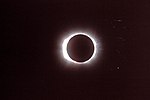 Totality in Brandon, MB, Canada |
February 26, 1979 Total |
0.8981 | 125 | August 22, 1979 Annular |
−0.9632 | |
| 130 | February 16, 1980 Total |
0.2224 | 135 | August 10, 1980 Annular |
−0.1915 | |
| 140 | February 4, 1981 Annular |
−0.4838 | 145 | July 31, 1981 Total |
0.5792 | |
| 150 | January 25, 1982 Partial |
−1.2311 | 155 | July 20, 1982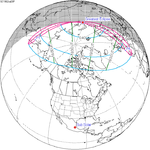 Partial |
1.2886 | |
Saros 145
[edit]This eclipse is a part of Saros series 145, repeating every 18 years, 11 days, and containing 77 events. The series started with a partial solar eclipse on January 4, 1639. It contains an annular eclipse on June 6, 1891; a hybrid eclipse on June 17, 1909; and total eclipses from June 29, 1927 through September 9, 2648. The series ends at member 77 as a partial eclipse on April 17, 3009. Its eclipses are tabulated in three columns; every third eclipse in the same column is one exeligmos apart, so they all cast shadows over approximately the same parts of the Earth.
The longest duration of annularity was produced by member 15 at 6 seconds (by default) on June 6, 1891, and the longest duration of totality will be produced by member 50 at 7 minutes, 12 seconds on June 25, 2522. All eclipses in this series occur at the Moon’s ascending node of orbit.[20]
| Series members 10–32 occur between 1801 and 2200: | ||
|---|---|---|
| 10 | 11 | 12 |
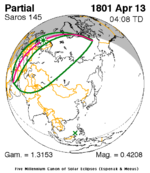 April 13, 1801 |
 April 24, 1819 |
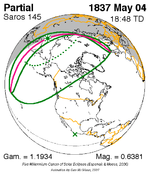 May 4, 1837 |
| 13 | 14 | 15 |
 May 16, 1855 |
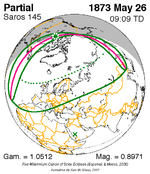 May 26, 1873 |
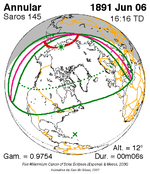 June 6, 1891 |
| 16 | 17 | 18 |
 June 17, 1909 |
 June 29, 1927 |
 July 9, 1945 |
| 19 | 20 | 21 |
 July 20, 1963 |
 July 31, 1981 |
 August 11, 1999 |
| 22 | 23 | 24 |
 August 21, 2017 |
 September 2, 2035 |
 September 12, 2053 |
| 25 | 26 | 27 |
 September 23, 2071 |
 October 4, 2089 |
 October 16, 2107 |
| 28 | 29 | 30 |
 October 26, 2125 |
 November 7, 2143 |
 November 17, 2161 |
| 31 | 32 | |
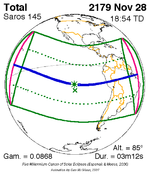 November 28, 2179 |
 December 9, 2197 | |
Metonic series
[edit]The metonic series repeats eclipses every 19 years (6939.69 days), lasting about 5 cycles. Eclipses occur in nearly the same calendar date. In addition, the octon subseries repeats 1/5 of that or every 3.8 years (1387.94 days). All eclipses in this table occur at the Moon's ascending node.
| 22 eclipse events between December 24, 1916 and July 31, 2000 | ||||
|---|---|---|---|---|
| December 24–25 | October 12 | July 31–August 1 | May 19–20 | March 7 |
| 111 | 113 | 115 | 117 | 119 |
 December 24, 1916 |
 July 31, 1924 |
 May 19, 1928 |
 March 7, 1932 | |
| 121 | 123 | 125 | 127 | 129 |
 December 25, 1935 |
 October 12, 1939 |
 August 1, 1943 |
 May 20, 1947 |
 March 7, 1951 |
| 131 | 133 | 135 | 137 | 139 |
 December 25, 1954 |
 October 12, 1958 |
 July 31, 1962 |
 May 20, 1966 |
 March 7, 1970 |
| 141 | 143 | 145 | 147 | 149 |
 December 24, 1973 |
 October 12, 1977 |
 July 31, 1981 |
 May 19, 1985 |
 March 7, 1989 |
| 151 | 153 | 155 | ||
 December 24, 1992 |
 October 12, 1996 |
 July 31, 2000 | ||
Tritos series
[edit]This eclipse is a part of a tritos cycle, repeating at alternating nodes every 135 synodic months (≈ 3986.63 days, or 11 years minus 1 month). Their appearance and longitude are irregular due to a lack of synchronization with the anomalistic month (period of perigee), but groupings of 3 tritos cycles (≈ 33 years minus 3 months) come close (≈ 434.044 anomalistic months), so eclipses are similar in these groupings.
The partial solar eclipses on December 18, 2188 (part of Saros 164) and November 18, 2199 (part of Saros 165) are also a part of this series but are not included in the table below.
| Series members between 1801 and 2134 | ||||
|---|---|---|---|---|
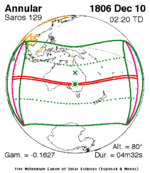 December 10, 1806 (Saros 129) |
 November 9, 1817 (Saros 130) |
 October 9, 1828 (Saros 131) |
 September 7, 1839 (Saros 132) |
 August 7, 1850 (Saros 133) |
 July 8, 1861 (Saros 134) |
 June 6, 1872 (Saros 135) |
 May 6, 1883 (Saros 136) |
 April 6, 1894 (Saros 137) |
 March 6, 1905 (Saros 138) |
 February 3, 1916 (Saros 139) |
 January 3, 1927 (Saros 140) |
 December 2, 1937 (Saros 141) |
 November 1, 1948 (Saros 142) |
 October 2, 1959 (Saros 143) |
 August 31, 1970 (Saros 144) |
 July 31, 1981 (Saros 145) |
 June 30, 1992 (Saros 146) |
 May 31, 2003 (Saros 147) |
 April 29, 2014 (Saros 148) |
 March 29, 2025 (Saros 149) |
 February 27, 2036 (Saros 150) |
 January 26, 2047 (Saros 151) |
 December 26, 2057 (Saros 152) |
 November 24, 2068 (Saros 153) |
 October 24, 2079 (Saros 154) |
 September 23, 2090 (Saros 155) |
 August 24, 2101 (Saros 156) |
 July 23, 2112 (Saros 157) |
 June 23, 2123 (Saros 158) |
 May 23, 2134 (Saros 159) | ||||
Inex series
[edit]This eclipse is a part of the long period inex cycle, repeating at alternating nodes, every 358 synodic months (≈ 10,571.95 days, or 29 years minus 20 days). Their appearance and longitude are irregular due to a lack of synchronization with the anomalistic month (period of perigee). However, groupings of 3 inex cycles (≈ 87 years minus 2 months) comes close (≈ 1,151.02 anomalistic months), so eclipses are similar in these groupings.
| Series members between 1801 and 2200 | ||
|---|---|---|
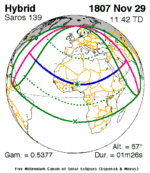 November 29, 1807 (Saros 139) |
 November 9, 1836 (Saros 140) |
 October 19, 1865 (Saros 141) |
 September 29, 1894 (Saros 142) |
 September 10, 1923 (Saros 143) |
 August 20, 1952 (Saros 144) |
 July 31, 1981 (Saros 145) |
 July 11, 2010 (Saros 146) |
 June 21, 2039 (Saros 147) |
 May 31, 2068 (Saros 148) |
 May 11, 2097 (Saros 149) |
 April 22, 2126 (Saros 150) |
 April 2, 2155 (Saros 151) |
 March 12, 2184 (Saros 152) |
|
References
[edit]- ^ "July 31, 1981 Total Solar Eclipse". timeanddate. Retrieved 9 August 2024.
- ^ "Muscovites view eclipse of the sun". Spokane Chronicle. Spokane, Washington. 1981-07-31. p. 3. Retrieved 2023-10-18 – via Newspapers.com.
- ^ "Bad weather hampers view of solar eclipse". Abilene Reporter-News. Abilene, Texas. 1981-07-31. p. 16. Retrieved 2023-10-18 – via Newspapers.com.
- ^ "Scientists Get Good Solar Eclipse Look". The Daily Advertiser. Lafayette, Louisiana. 1981-07-31. p. 6. Retrieved 2023-10-18 – via Newspapers.com.
- ^ "Former Beatrician among group studying eclipse in Russia". Beatrice Daily Sun. Beatrice, Nebraska. 1981-07-31. p. 3. Retrieved 2023-10-18 – via Newspapers.com.
- ^ "Clouds obstruct most of Soviet eclipse". Springfield Leader and Press. Springfield, Missouri. 1981-07-31. p. 17. Retrieved 2023-10-18 – via Newspapers.com.
- ^ "High-flying scientists view moon's path across sun". The Kokomo Tribune. Kokomo, Indiana. 1981-07-31. p. 13. Retrieved 2023-10-18 – via Newspapers.com.
- ^ "Long eclipse". Liverpool Echo. Liverpool, Merseyside, England. 1981-07-31. p. 1. Retrieved 2023-10-18 – via Newspapers.com.
- ^ "Black day for Reds". Manchester Evening News. Manchester, Greater Manchester, England. 1981-07-31. p. 1. Retrieved 2023-10-18 – via Newspapers.com.
- ^ "Clouds spoil view of eclipse of sun". Calgary Herald. Calgary, Alberta, Canada. 1981-07-31. p. 14. Retrieved 2023-10-18 – via Newspapers.com.
- ^ "Total eclipse". North Bay Nugget. North Bay, Ontario, Canada. 1981-07-31. p. 2. Retrieved 2023-10-18 – via Newspapers.com.
- ^ "Weather blocks eclipse view". Edmonton Journal. Edmonton, Alberta, Canada. 1981-07-31. p. 48. Retrieved 2023-10-18 – via Newspapers.com.
- ^ "Hundreds of scientists study eclipse of sun". Standard-Speaker. Hazleton, Pennsylvania. 1981-08-01. p. 5. Retrieved 2023-10-18 – via Newspapers.com.
- ^ "Americans Join Scientists to Observe Eclipse". Tulsa World. Tulsa, Oklahoma. 1981-08-01. p. 32. Retrieved 2023-10-18 – via Newspapers.com.
- ^ "Eclipse casts its giant shadow across 4,300-mile Soviet path". Arizona Daily Star. Tucson, Arizona. 1981-08-01. p. 2. Retrieved 2023-10-18 – via Newspapers.com.
- ^ "Moon Distances for London, United Kingdom, England". timeanddate. Retrieved 9 August 2024.
- ^ R. R. Fisher, L. B. Lacey, K. A. Rock, E. A. Yasukawa, N. R. Sheeley Jr., D. J. Michels, R. A. Howard, M. J. Koomen, A. Bagrov (March 1983). "The Solar Corona on 31 July, 1981" (PDF). Solar Physics. 83: 233–242. ISSN 0038-0938.
{{cite journal}}: CS1 maint: multiple names: authors list (link) - ^ "Total Solar Eclipse of 1981 Jul 31". EclipseWise.com. Retrieved 9 August 2024.
- ^ van Gent, R.H. "Solar- and Lunar-Eclipse Predictions from Antiquity to the Present". A Catalogue of Eclipse Cycles. Utrecht University. Retrieved 6 October 2018.
- ^ "NASA - Catalog of Solar Eclipses of Saros 145". eclipse.gsfc.nasa.gov.
External links
[edit]- Earth visibility chart and eclipse statistics Eclipse Predictions by Fred Espenak, NASA/GSFC
- Solar Corona Shape
Photos:




